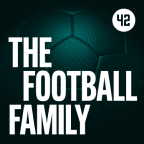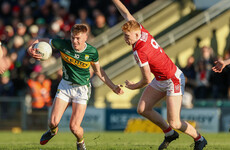This post is part of The42′s Facing History series, supported by Cadbury Boost. To read more, click here.
ONE SIDE OF Pat Lam’s office at the Sportsground in Galway is taken up by a large bookcase.
Names like John Wooden, Carol Dweck and Bill Walsh stand out on the spines of the hundreds of books. Lam enjoys reading about and discussing the art of coaching and psychology, not specifically limited to rugby.
On another wall, this one opposite the Connacht head coach’s desk, is a whiteboard with various reminders and ideas scrawled across it, but there’s one permanent quote at the top that won’t ever be wiped away.
“I have no business doing what I do if I listen to people who have no idea or experience about what I do.”
Lam got that one from Wayne Bennett, the legendary Brisbane Broncos boss who has been an influence on many coaches outside of rugby league.
Lam has mentioned this quote a number of times in his media dealings in recent years and you might think he recalls it in periods of doubt, but the truth is that the 48-year-old has developed genuine confidence in what he does.
Connacht’s poor start to the season may have rattled people on the outside of the province, but Lam was calm. He understood that the blip was fleeting, that it would pass as Connacht’s level of performance returned to its mean – which is now high-quality.
Rugby has been Lam’s life, allowing a shy Samoan boy to grow into the leader he is today. His family are priority number one, of course, but the oval ball game has been almost ever-present as a source of happiness and the focus of Lam’s intellectual powers.
Born in Auckland in 1968, Lam’s journey is also crucial in understanding a prominent strand of New Zealand rugby. His family is Samoan, their traditions those of the Pacific Island, but Lam was part of the transformation of Auckland rugby.
Today, the Auckland scene is dominated by players of Polynesian descent, many of them Samoans like Lam.
The contributions of players with Pacific Island backgrounds to New Zealand rugby is beyond dispute – the likes of Jerome Kaino, Keven Mealamu, the Savea brothers, Joe Rokocoko, Tana Umaga, Victor Vito, the list goes on and on and on.
These men are celebrated as a key part of New Zealand rugby now and Auckland – the world’s largest Polynesian city - continues to produce hundreds of talented players for the sport.
It wasn’t always the case that Pacific Islanders were celebrated in New Zealand rugby. Indeed, as the second generations of Pacific Islander immigrants began to excel in rugby, there was even concerned talk of the ‘browning of the All Blacks’.
There were initially stereotyped notions that Polynesian players were only good for smashing each other in the collisions and that their growing influence would ‘dumb down’ New Zealand rugby.
Lam was something of a trailblazer. A born and bred Aucklander, he was very much a Samoan boy nonetheless. Of course, he ended up playing Test rugby for Samoa but he understands the Auckland scene, and the Polynesian influence on it, better than most.
Lam grew up in the suburb of Avondale, which used to be part of West Auckland but is now on the border of Central Auckland, such has been the sprawl of the city.
“I was always West side and then there’s guys like Bundee [Aki] from the South side. That’s probably why Connacht was a good fit for me – the West side!”
The rugby pitch in Avondale College served as Lam’s back yard as he grew up, and he spent countless hours on that field playing with his friends. He was just four-years-old when he was involved in his first game.
“I remember even before I got to primary school, my uncle coached a team. My cousins who we grew up with, he coached their team. I was on the sideline and I was quite a big boy even when I was four.
“They were short [on numbers] to play. It was seven-a-side playing in your bare feet and that’s where I first got introduced to it.
“By the time we got to primary school, everyone played at lunch time. On a Saturday, it wasn’t a case of, ‘Is everyone going to show up?’ It was a case of, ‘How many teams do we have? Where can we fit everyone?’”
As the little boy with “the brown face”, Lam was an exception to the norm. His parents are both Samoan but came to New Zealand, where they met, in order to find work and raise a family.
That wider-scale immigration was only beginning back then, and Lam stresses that rugby was important for him in integrating into life in Auckland.
“In primary school, it pretty much gave me my identity because I was pretty shy. Where I was at, there wasn’t too many Pacific Islanders in the school.
“I would say back in the ’70s and ’80s, Pacific Islanders were seen as the factory workers, they were seen as not the top echelon of society, if you like.”
Lam’s first memory of watching the All Blacks is a 1975 game against Scotland at Eden Park [or 'Lake Eden'], when the pitch was flooded but the match continued.
All eyes in the Lam household were on Bryan Williams – an Auckland native whose father was Samoan and whose mother was also of Samoan descent.
“He stood out because he was the only Pacific Islander in the team,” says Lam. “You look at the team now, look at my school, and the kids there now – it’s a lot of brown faces.
“You look at the changing of the All Black faces, Auckland rugby and club rugby. There are so many Pacific Islanders playing now. It all started to happen in the late ’90s and the early 2000s, the second generation Samoans coming through, and it completely changed the shape of New Zealand rugby I think.”
Lam’s secondary schooling took place at St. Peter’s College, a Catholic state school close to the city centre.
The Grafton-based school had never won a prestigious Auckland 1A title when Lam first joined, while they’d also never tasted a home success in the ‘Battle of the Bridge’ against bitter rivals Auckland Grammar, a much bigger school situated just 250 metres down the road. Lam was enthralled by the focus on rugby.
“Even the team announcements, there was a big board on the wall and the team would be chalked up there,” he recalls with a smile.
“Everyone would be waiting around on Thursday afternoon to see who was going to make the First XV. It was such a big occasion. As a 12 or 13-year-old I was thinking ‘Wow, this is massive.’”
As Lam established himself and began helping St. Peter’s to success, his confidence as a person grew.
“It changed me completely because I wasn’t a natural leader. When you’re in a big school, as soon as you walk on the field everyone’s playing rugby and you join in. I was playing with older guys because I was big and you might bump someone off and word gets around, ‘Oh, he’s a good rugby player.’
“The teachers who are rugby coaches start coming up and having chats to you about going into their team and you start getting a few favours, and quickly start working out that rugby has a lot of benefits in a rugby school.
“Even to the point that one of the teachers would give me the squash court or the gym to use; I had my own key to go in any time. There was a lot of perks in playing rugby!”
For Lam’s parents, his progress into the First XV was also vital in bringing them into New Zealand society.
While Samoan culture remained a huge part of the Lam’s family life, the exposure to the parents of Pat’s team-mates on the St. Peter’s First XV helped them to integrate.
“I think it completely changed my parents,” says Lam. “When I was young, discipline was strong in Samoan culture. You pretty much got a smack if you did things wrong and I appreciate that because it taught us right and wrong.
“You’re not allowed do that now obviously, the law says you can’t. My parents were firm and fair, but I think what happened was, growing up the New Zealand way, the parents in the First XV were a strong community.
“Each set of parents was rostered to have a team party or dinner after each game.
“My parents just saw there was a different way to do things and they felt a real bond with all the other parents in the school. They ended up being life-long friends and I think that gave my parents good insight – because traditionally it was just work and come home to family – but they met a whole new group.
“They were extremely proud of me making the First XV and that’s when you sort of recognise, maybe I’ve got something here.”
He would later feel that same pride when his own sons came through the St. Peter’s ranks.
Lam’s playing ascent continued with selection to the Auckland U16s, New Zealand U17s and Schools, and eventually the senior Auckland provincial set-up. The game was still amateur at that time in the early ’90s but Lam loved the honour.
There were three National Provincial Championships for Auckland in Lam’s five years there, while he was also involved in the latter part of the incredible streak that saw Auckland defend the Ranfurly Shield 61 times between 1985 and 1993.
Graham Henry was in charge for Lam’s last two years with Auckland, becoming an important figure in his transition into coaching later on.
“Effectively, when I came through in Auckland, it was a really good example of professionalism not being about the money,” says Lam. “It was all around the attitude and the way you did things.
“I remember coming to training and straight away you knew where you had to sit and so forth, but in training you just did not make a mistake. They would record any ball that went down and they could say, ‘A ball hasn’t been dropped for three weeks.’
“People were diving to catch passes! You learn pretty quickly that there was a seniority but there were standards and they came hard at you. You had to toughen up or you’d get kicked out.
“Everything was around leading standards and it didn’t surprise me that so many of those players went on to represent New Zealand. They really led it in that area in the transition from amateur to professional.”
The love of Samoa never left Lam, with trips to the island to visit his relatives keeping it alive and he was capped by his parents’ native land in 1991, going on to win 34 caps, captain them and play in three World Cups.
He did play for the All Blacks once in 1992 but it was a non-Test game against a Sydney team and he therefore did not go down the route trodden by the likes of Bryan Williams in adopting New Zealand as his Test nation.
After spells with North Harbour, the Crusaders, Newcastle and Northampton – taking him into the professional era – Lam hung his boots up and moved into coaching in a role as Ian McGeechan’s assistant with Scotland in 2003.
‘Geech’ was an important mentor and Lam enjoyed making the trips across to Europe for international camps with the Scots, but Auckland came calling in 2004 and the local boy jumped at the opportunity to head coach his home province.
His Auckland squad included many players with backgrounds like his own, Polynesian descent. What is it that makes Samoans, Tongans and Fijians such good rugby players?
“Of course, there’s the physicality, the combat, all of that sort of stuff. They’re built for it really. It was a natural fit, a natural game for Pacific Island men.”
But more than that, Lam believes that the sheer importance of family in the Pacific Islands has meant the adaptation to rugby was a natural one.
“Pacific Islanders are very similar to the Irish – it’s about family,” says Lam. “It’s all about ‘bro’, ‘cuzzy’, ‘cuzzybro’, ‘hey, brother’ and the way it was in the Pacific Islands, the grandparents, the children, the grandchildren, everyone was in the same area.
“Even when I go back to my cousins [in Samoa], they’re all neighbours. Everything is built around extended family and the reason they could have so many kids is because everyone looks after everybody.
“When you go there, there’s a lot of song, a lot of dance. As you see with Bundee, they can all dance and entertain! I think that sense of belonging is about being part of a group and that’s why so many are involved in team sports rather than individual sports.”
The physical prowess of the players Lam was working with in Auckland wasn’t in any doubt, nor was their skill set.
He took a year to fully understand how he needed to organise his team in the disjointed nature of the season, but won the NPC in 2005 and then did so again in 2007 in an undefeated campaign.
That title remains the last one Auckland has won, as the sheer level of talent in the province has not been turned into further success.
“It’s about trying to get a structure where that talent can come out, but at times that was difficult because some guys grow up as players who can make something out of nothing,” says Lam on the subject of getting the most out of the Polynesian talent in Auckland.
“Say if you have a 4 v 3 but the first guy just steps and goes and looks to beat them himself. That’s good, that’s fine, but sometimes the other players get reliant on that player, or that player gets reliant on his own ability and then he finds out that sometimes he can’t do that because the picture has changed. That’s where it breaks down.
“That was one of the biggest challenges – to make it all about team and to get everyone understanding their roles.”
Lam’s success led to him landing the Blues job in Super Rugby in 2009 and he guided the Auckland-based franchise into a semi-final in 2011 before his stint ended in disappointment in 2012.
The breaking apart of, and “in-fighting” between, Auckland and the Blues was disruptive and a relationship that had helped the Blues win three Super Rugby titles has not yet fully recovered.
Lam looks back on that 2012 season with the Blues as a valuable lesson in his coaching career now, while his love for Auckland remains undiminished.
“I’m always proud, it will always be my home team,” says Lam. “When I think of Auckland, I think of home. That’s where I was born and bred, even if it’s not my kids’ home now.
“I was very privileged to play for them, coach them and to win championships as a player and as a coach, but for me now it’s about what I do with whoever I’m working with. All of those experiences have brought me here to where I am.
“When I came here to Connacht, it was about trying to replicate what Auckland was for me. The only way I get a sense of home is to get to know the people, and I’m not even talking about the rugby people.
“Get to really know the people and that gives you a sense of responsibility and what it’s about. If I didn’t really enjoy that, I’d probably go.”
The42 is on Snapchat! Tap the button below on your phone to add!

















the ronald mcdonald house is a fantastic facility. we had to stay at one for a few months a few years back.
Go eagles
Ron, The Polish Rifle!!